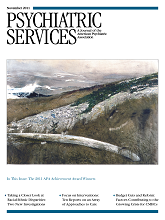News Briefs
SAMHSA report on mental illness prevalence by state: A state-by-state analysis of the prevalence of any mental illness and serious mental illness found significant variation. Nationally, 44.5 million adults aged 18 or older (19.7% of the adult population) experienced any mental illness in the past year. The highest rate of any mental illness occurred in Rhode Island (24.2%), and the lowest rate was in Maryland (16.7%). Nationally, 10.4 million adults (4.6% of the adult population), experienced a serious mental illness in the past year (defined as causing substantial functional impairment), with rates ranging from 3.5% in Hawaii to 7.2% in Rhode Island. Arkansas, Idaho, Rhode Island, Utah, and West Virginia had the highest rates for both any mental illness and serious mental illness. Alaska, Maryland, North Dakota, Pennsylvania, South Dakota, and Virginia had the lowest rates across both measures. The six-page report was released by the Substance Abuse and Mental Health Services Administration (SAMHSA) and is based on data from the 2008 and 2009 National Surveys on Drug Use and Health. State Estimates of Adult Mental Illness is available on the SAMHSA Web site at oas.samhsa.gov/2K11/078/WEB_SR_078.cfm.
Kaiser Commission details options to expand access to Medicaid HCBS: When the Medicaid program was first established, nursing home services were a mandatory benefit. Many home- and community-based services (HCBS) were later added as optional benefits. For two decades, states and the Centers for Medicare and Medicaid Services have made substantial efforts to expand access to Medicaid HCBS. These initiatives stem from the growing demand by people with disabilities to receive services in their homes, rather than being institutionalized. A newly released background paper from the Kaiser Commission on Medicaid and the Uninsured examines aspects of the Medicaid program that can expand access to and rebalance long-term care spending in favor of HCBS. The 17-page paper describes the three major categories of Medicaid HCBS benefits available to states. Various ways of measuring HCBS access are discussed, and states rated highest and lowest on access are identified. Benefits and policies that appear to contribute to high HCBS access are described, and new options and incentives for states to expand HCBS under health care reform are discussed. State Options That Expand Access to Medicaid Home and Community-Based Services is available on the Kaiser Commission Web site at www.kff.org/medicaid/8241.cfm.
Survey finds growth in health care premiums outstrips wage growth: Annual premiums for employer-sponsored family health coverage increased to $15,073 this year, up 9% from last year, according to the Kaiser Family Foundation/Health Research and Educational Trust 2011 Employer Health Benefits Survey. The 13th annual survey found that on average, workers currently pay $4,129 and employers pay $10,944 toward premiums. In 2011 premiums increased significantly faster than workers' wages (2.1%) and general inflation (3.2%). Since 2001, family premiums have increased 113%, compared with 34% for wages and 27% for inflation. This year's survey also looked at employers' experiences with newly implemented provisions of the 2010 health care reform law that affect employer coverage. Employers added 2.3 million young adults to their parents' policies as a result of a provision that allows young adults up to age 26 without their own employer coverage to be covered as dependents on their parents' plan. The survey also found that 31% of covered workers are in high-deductible plans. Covered workers in smaller firms (three to 199 workers) are more likely to have high deductibles, with half facing deductibles of at least $1,000, including 28% with deductibles of $2,000 or more. These numbers in part reflect the rise of consumer-driven plans—high-deductible plans that include tax-preferred savings options, such as a health savings account or health reimbursement arrangement. The proportion of covered workers enrolled in this type of plan has doubled, from 8% in 2009 to 17% in 2011. The survey also found that 56% of covered workers are in “grandfathered” plans, which are exempted from some health care reform requirements. To obtain this status, employers cannot make significant changes to their plans that reduce benefits or increase employee costs. The 222-page survey report and supplemental materials are available on the Kaiser Foundation Web site at ehbs.kff.org.
Mental health care gaps for American Indians and Alaska Natives: A new report highlights serious gaps in mental health care for many American Indians and Alaska Natives. One in five hospitals and clinics on reservations provide no mental health services, according to the report by the Inspector General of the Department of Health and Human Services. Only half provide drug abuse treatments, and at dozens of facilities such treatment is conducted by unlicensed staff. The 36-page report, which lists several recommendations for improving treatment availability, is based on a January 2008–June 2009 survey of Indian Health Service and tribal facilities and site visits to 98 facilities. It is available at oig.hhs.gov/oei/reports/oei-09-08-00580-00581.asp.



